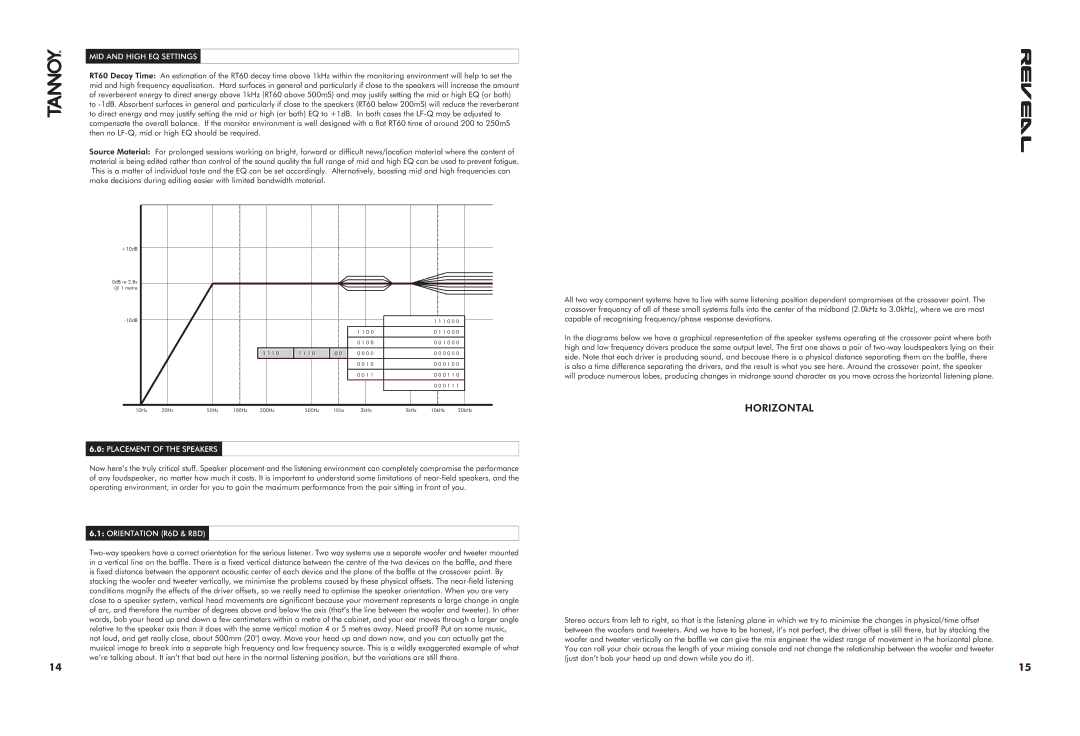
MID AND HIGH EQ SETTINGS
RT60 Decay Time: An estimation of the RT60 decay time above 1kHz within the monitoring environment will help to set the mid and high frequency equalisation. Hard surfaces in general and particularly if close to the speakers will increase the amount of reverberent energy to direct energy above 1kHz (RT60 above 500mS) and may justify setting the mid or high EQ (or both) to
Source Material: For prolonged sessions working on bright, forward or difficult news/location material where the content of material is being edited rather than control of the sound quality the full range of mid and high EQ can be used to prevent fatigue. This is a matter of individual taste and the EQ can be set accordingly. Alternatively, boosting mid and high frequencies can make decisions during editing easier with limited bandwidth material.
+10dB |
|
|
|
|
|
|
|
|
|
|
0dB re 2.8v |
|
|
|
|
|
|
|
|
|
|
@ 1 metre |
|
|
|
|
|
|
|
|
|
|
|
|
|
|
|
|
|
| 1 1 1 0 0 0 | ||
|
|
|
|
|
|
| 1 1 0 0 |
| 0 1 1 0 0 0 | |
|
|
|
|
|
|
| 0 1 0 0 |
| 0 0 1 0 0 0 | |
|
|
|
| 1 1 1 0 | 1 1 1 0 | 0 0 | 0 0 0 0 |
| 0 0 0 0 0 0 | |
|
|
|
|
|
|
| 0 0 1 0 |
| 0 0 0 1 0 0 | |
|
|
|
|
|
|
| 0 0 1 1 |
| 0 0 0 1 1 0 | |
|
|
|
|
|
|
|
|
| 0 0 0 1 1 1 | |
10Hz | 20Hz | 50Hz | 100Hz | 200Hz | 500Hz | 1Khz | 2kHz | 5kHz | 10kHz | 20kHz |
6.0: PLACEMENT OF THE SPEAKERS
Now here’s the truly critical stuff. Speaker placement and the listening environment can completely compromise the performance of any loudspeaker, no matter how much it costs. It is important to understand some limitations of
6.1: ORIENTATION (R6D & R8D)
14
All two way component systems have to live with some listening position dependent compromises at the crossover point. The crossover frequency of all of these small systems falls into the center of the midband (2.0kHz to 3.0kHz), where we are most capable of recognising frequency/phase response deviations.
In the diagrams below we have a graphical representation of the speaker systems operating at the crossover point where both high and low frequency drivers produce the same output level. The first one shows a pair of
HORIZONTAL
Stereo occurs from left to right, so that is the listening plane in which we try to minimise the changes in physical/time offset between the woofers and tweeters. And we have to be honest, it’s not perfect, the driver offset is still there, but by stacking the woofer and tweeter vertically on the baffle we can give the mix engineer the widest range of movement in the horizontal plane. You can roll your chair across the length of your mixing console and not change the relationship between the woofer and tweeter (just don’t bob your head up and down while you do it).
15
